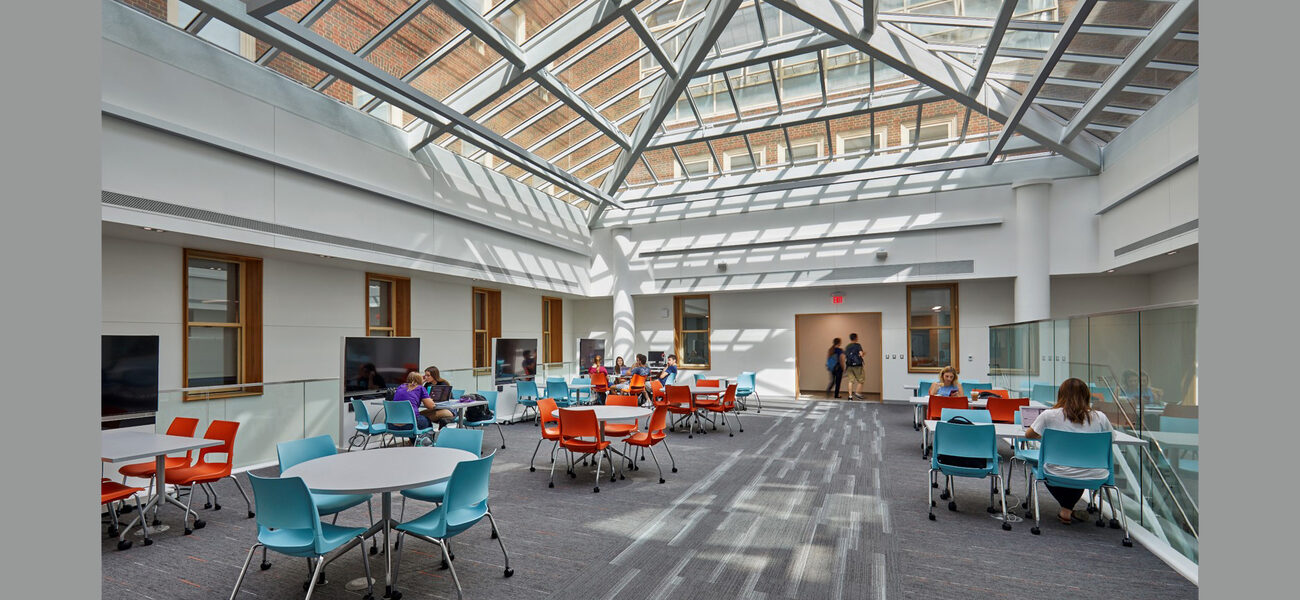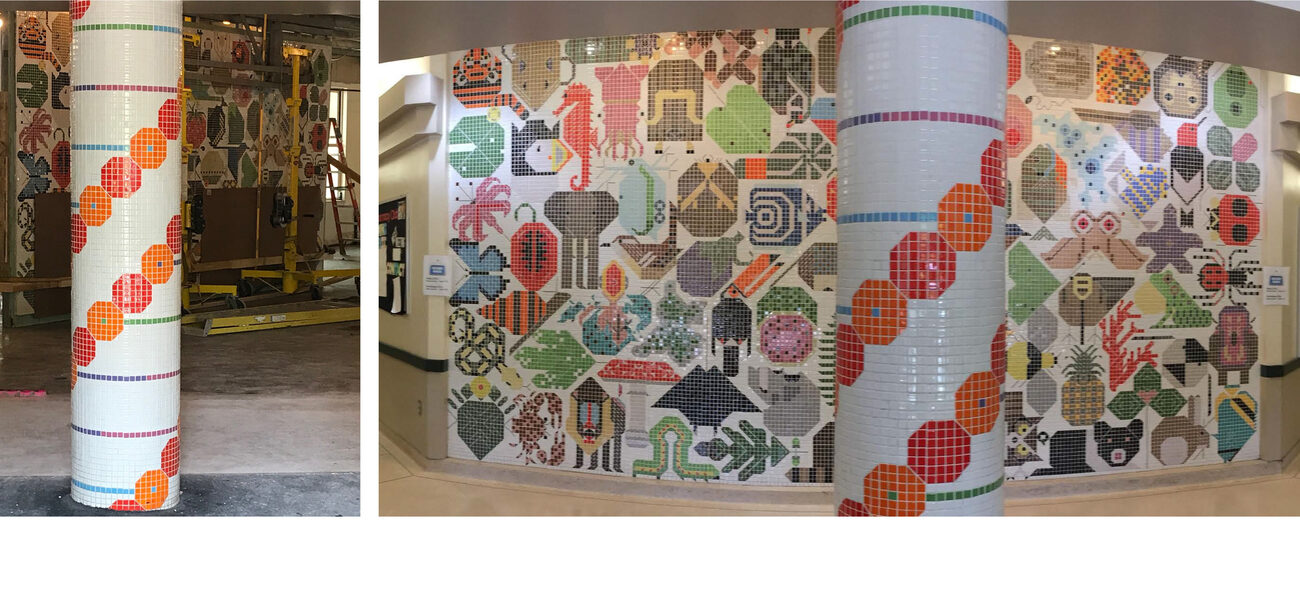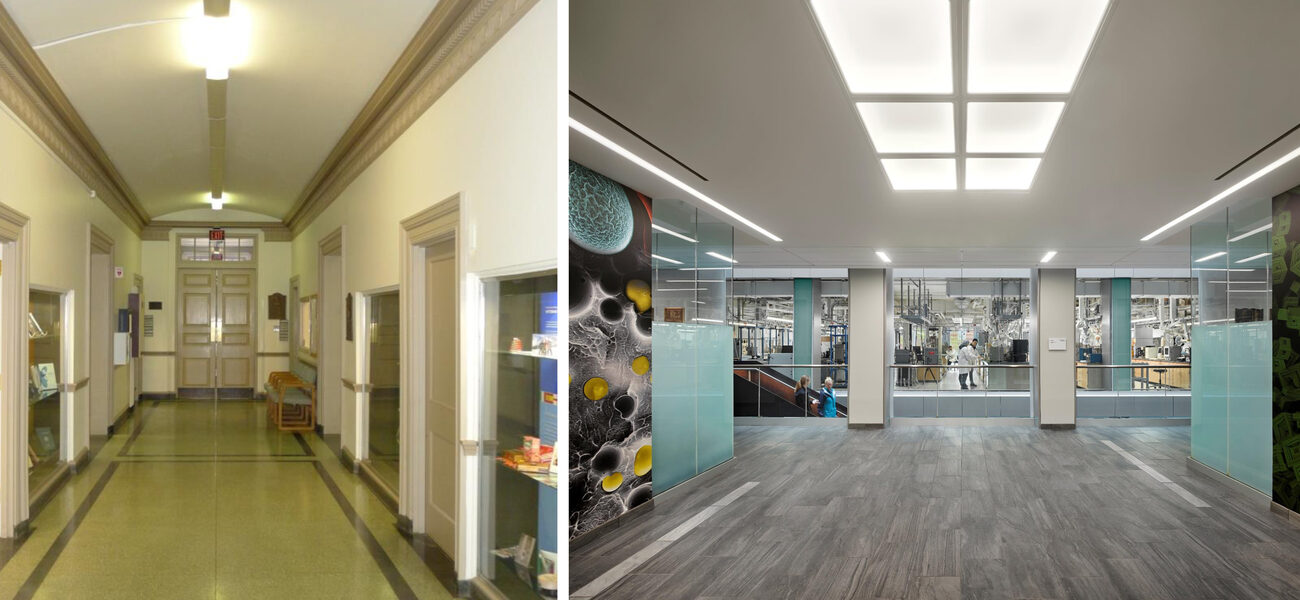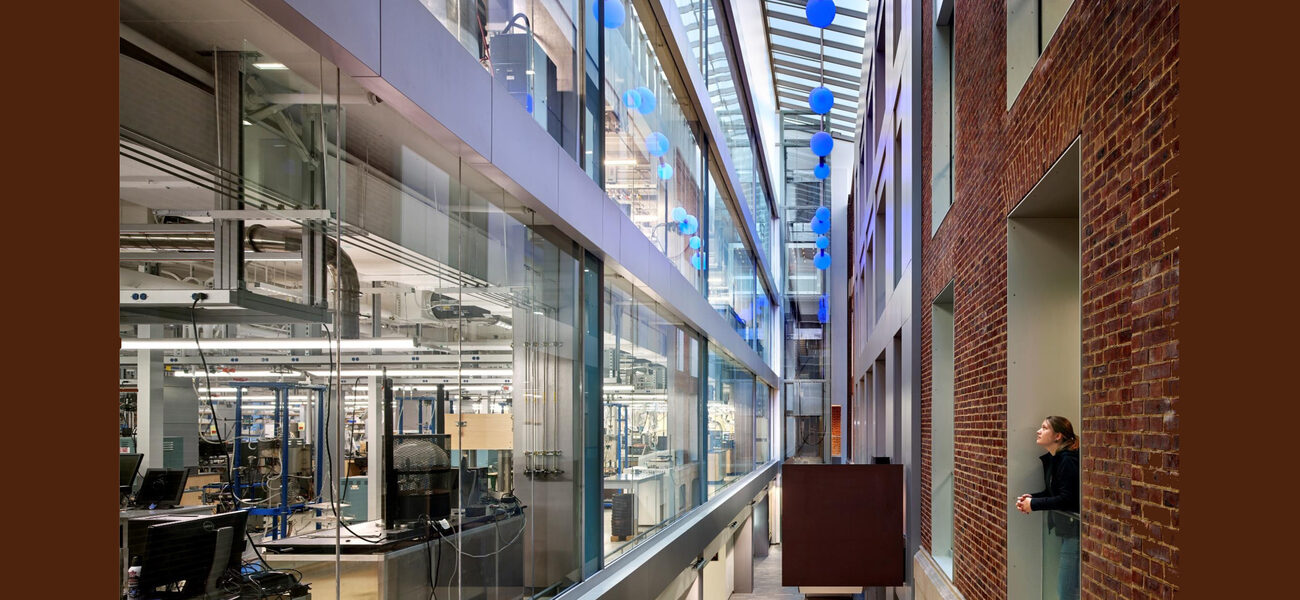Miami University and The Pennsylvania State University have transformed outdated buildings into modern STEM teaching and research centers while maintaining some of each building’s historic aspects. The projects aim to replace siloed labs, dark corridors, and dated HVAC systems with collaborative research facilities and up-to-date mechanicals, recapturing wasted space to provide areas where students can gather. Swing space for affected occupants was crucial—Miami University’s Pearson Hall remained partially occupied during construction, while Penn State’s Steidle Building was vacated—as was clear and frequent communication with faculty and other building users. Both projects required fairly complex phasing.
Miami University’s Pearson Hall houses biology and microbiology departments, serving biology, microbiology, zoology, and botany students. About 80 percent of the university’s undergraduates utilize the building, and 8,000 students take classes there each year. Undergraduate research is a big part of this school’s focus, with an estimated 96,000 hours of laboratory and related research conducted annually by undergraduate and graduate students. The renovation, scheduled for completion in 2020, will decrease square footage of lab space but increase efficiency, flexibility, and usability of the facility, from 100,295 nsf to 110,285 nsf.
In addition to bringing mechanicals into the 21st century, the $65 million project (approximately $365 per sf) trades small research spaces and dark corridors for collaborative labs and bright, open spaces. It also adds places, nonexistent in the 1980s building, where students can gather or study. In particular, architects designed shared lab spaces with a focus on collaboration and adaptability.
“The thought behind the shared lab was partly to foster collaboration among faculty who were naturally associated with common research interests,” says Thomas O. Crist, professor and chair of the Department of Biology. “But the other thing is that it provides us more flexibility in how that space is allocated among researchers. As a researcher is winding down their research operation, they may not need as much space. Another person who might have a lot of grant money and a bigger operation can expand.”
The project’s architect, Eileen Pedersen, AIA, LEED AP BD+C, a senior associate at Perkins+Will, explains that PI space can expand and contract as needed, because labs have fewer walls. The renovated space provides an average of 790 sf of open lab and 360 sf of research lab support per PI, which equates to about 98 linear feet. This provides seats for one post doc and three or four graduate student seats per PI, plus a varying number of undergrads, 70 percent of whom will gain research experience in their four years on campus. Teaching labs have also given students more space, expanding from 30 to 35 sf per student to between 50 and 55 sf per student.
Built in 1930 and designed by prominent Philadelphia architect Charles Klauder, Penn State’s Steidle Building is part of the university’s registered historic district of core campus buildings. Steidle had changed little since its construction. Home to the materials science and engineering program—whose undergraduate program has grown 150 percent since 2007—the building had tight corridors, small rooms, and no areas where people could gather.
“This was the literal antithesis of science on display. You would walk through this building and not even know there were occupants in there,” says Dwayne Rush, Penn State’s project manager. “As far as systems go, the building was very poor. There were numerous power bumps and brownouts. The researchers could never count on power running continuously, even for 24-hour periods. There was poor to no HVAC through most of the building, and the controls systems were unreliable at best.”
In addition to updating crucial HVAC and electrical systems, the renovation aimed to maintain Steidle’s historic character while forming research clusters and shared research facilities to help promote cross-disciplinary collaboration. The reworked building, which opened in 2016, now includes collaborative labs, student lounges, and a 48-seat computer lab. In all, 66,000 gsf was renovated and 34,000 gsf of new construction built during the two-year, $52 million project. EYP served as architects and engineers, and Mascaro as construction manager.
Importance of Swing Space
Projects that make buildings unusable during construction require alternate space on campus where research and learning can continue. Because Pearson Hall has remained partially occupied throughout construction, swing space was necessary to move faculty, students, and staff who were affected at each phase. In fact, nearby Hughes Hall had to be renovated first to create swing space for Pearson.
“There were some minor renovations done to office and teaching spaces, but the primary scope of the renovation was the second floor of Hughes Hall,” explains Crist. “This is an open floorplan that accommodates 13 of our biology and microbiology faculty, and about a third of our total faculty moved over to this space. It is an open arrangement with just a few sub-rooms to accommodate specific needs, but we also had to plan for the future of this space, which will eventually be used for collaborative projects in engineering and the natural sciences.”
In all, the project will involve four sets of moves into and out of Hughes. A main goal, however, was to ensure no one moved more than twice. And because the project focuses on Pearson not Hughes, the university did not want to invest too much of the budget renovating swing space.
“We were dealing with about four different flavors of really specialized lab support space—warm rooms, cold rooms, tissue culture, and generic lab support space that could either be a rig room or something else like that,” explains Pedersen. “The challenge was less about customizing and more about making sure the right numbers of lab support spaces were actually in Hughes Hall, so we didn’t have 10 PIs who needed access to a warm room swinging into the building at the same time.”
Penn State’s project called for an unoccupied building during the Steidle Building’s two-year renovation, displacing 200 people. Some researchers moved to mobile labs housed in trailers and others to spaces that had to be renovated for their use.
“I can’t say swing space enough,” says Rush. “We should have treated the renovation of the various swing space areas like a typical project, with design meetings and a CM to manage. Instead, I was more or less doing it on the fly and didn’t realize the amount of work that would be needed to get the spaces ready for the researchers. As a result, every day that we delayed moving the people into swing space was a day later that we could start the renovation. This pushed the schedule to the point of doing concrete work in the winter.”
Time for Phasing
Technically, the Miami University project has two phases—Phase 1, focused mostly on classrooms with some work on research labs, and Phase 2, which completed the balance of the research labs—but sub-stages make it more like five phases overall. Plotting out and scheduling everything became a puzzle that took six months to solve, the main constraints being the switch from a VAV to chilled beam HVAC system and the goal of minimizing moves. The school needed classroom space and teaching labs to remain useable during the school year, so the team designed “summer slams” to get work done in those areas.
“Through the programming process, we had a pretty good idea of how phasing was going to work,” says Pedersen. “Then within schematic design of Phase 1, the rubber really hit the road. The design–build team was on board, there was contractor input, and things shifted. Phasing in concept is very different than construction phasing in reality, and I have to credit Messer and BSA Life Structures. They had to make sure they had the access they needed to the exterior, and that construction workers coming in and out didn’t disrupt the daily life of faculty and students who were using the building.”
Repairing old equipment and timing moves became more puzzle pieces.
“For things like freezer rooms, where you have maybe six or seven minus-80 freezers, you need to make sure you have a space for all of them, because you just don’t have enough places to put all of the material that needs to be stored at minus-80,” explains Crist. “All of the electrical connections have to be set up just right for the idiosyncratic power requirements of every minus-80. Those details are things that hang you up in that phasing process.”
At Penn State, even though the building was vacated for two years to accommodate construction, phasing was still necessary, because the Steidle Building shared HVAC with a neighboring building that remained occupied.
“We couldn’t simply demo everything out and then put all the new in,” says Rush. “We had to do it a piece at a time, and that made it more challenging.”
Rush relied on his construction manager to plan when each system would be brought offline. Generally, the crew worked on systems during opposite seasons—cool air components during winter months and heating during the summer.
Electrical systems posed a different challenge. “We scheduled shutdowns during overnight or weekend hours and provided generators where needed,” explains Rush. “For instance, we had low-temp freezers with glacier samples that couldn’t be allowed to melt, so we had to put generators on those. Other people would shut down their research for a 24-hour period when necessary.”
Focus on Communication
In addition to minimizing moves at Miami University, Crist and Luis A. Actis, professor and Chair of the Department of Microbiology, tried to meet researchers’ needs but also help ease them through the cultural adjustment to a new type of building with more open, shared spaces.
“We have a lot of senior faculty who have had a space their whole life, so that was a challenge,” says Crist. “It required a lot of communication on my part to describe the benefits of this new type of arrangement.”
Providing end users with clarity throughout the separate phases was important to Crist, as well as to the architects and design–build team, especially considering building users would be living through three years of construction. Crist and Actis served as the points of contact between the design–build team and the university, a role they didn’t realize would consume so much of their time.
“There’s a good reason all the end users can’t communicate with the construction folks or the project managers,” says Crist. “I’m that go-between. The biggest challenge is during those critical periods where big changes are taking place, trying to keep all the demands of my regular job going while managing that.”
Unsurprisingly, researchers were particularly concerned about equipment, so the team worked to communicate where critical pieces of shared equipment would be throughout the design phases. For each phase, they put together a number of diagrams showing the location of each autoclave, for instance, how many glasswashers researchers would have, where ice machines and dryers would be, and who would be moving where.
“We definitely went overboard with the amount of information that was on some of these diagrams,” says Pedersen. “A lesson learned is really making sure to tailor each piece of communication for its intended audience.”
Reclamation of Space
Penn State’s project reclaimed outdoor space out of necessity. Once the 1930s-era building had been brought to code, the team realized they would lose about 8,000 asf. “What that meant was that either seven PIs and their groups were going to need to move to another building, or the number of staff per principal investigator was going to be reduced by five, which meant about 70 or 80 people currently in Steidle would have to find a home somewhere else,” says Rush.
Instead, the team decided to demolish a center wing that had been added in 1940, which shaped the structure like a capital “E.” Removing that middle wing turned the building into a “C,” and the resulting courtyard was filled with new construction, leaving the historic exterior brick-and-limestone wall as a now-interior wall. “That’s a feature everyone loves,” says Rush.
Labs occupy the new area, and a four-story atrium between the labs and the old exterior increases the amount of natural light in the building. The team ended up adding glass walls in openings overlooking the atrium on the third and fourth floors, to prevent the need for a smoke evacuation system required by code in atriums higher than two levels. Demolishing the center wing and constructing the four-story infill space added $10 million to the project’s budget, though avoiding the need for a smoke evacuation system kept that cost from rising further.
In total, Miami University gained around 10,000 sf, by switching to chilled beam—which requires less duct space than the traditional VAV system it replaced and allowed transition of third-floor mechanical space into teaching areas—and by filling in an outdoor courtyard.
“Everybody wanted this building to feel like a home for students and not just a place where they would come for class and then immediately leave afterwards, because there was no place for them to be,” says Pedersen.
To that end, the courtyard is now a two-level atrium, which serves as the focal space of the building, with student study space at the ground level and a flexible classroom below grade that has so far been used for seminars and thesis defenses.
“The architects designed it in a way that allows light to filter down from the atrium, so when you’re in that room, you experience a lot of natural light even though you’re in the basement,” explains Crist.
Additional Challenges
Faculty turnover: As the Pearson Hall project began, Miami University faced a large number of faculty retirements and increased acquisitions—five new hires over the past three years, with more to come. New researchers bring different lab needs that can’t always be anticipated. “The nice thing about the open, flexible spaces is they accommodate most of the needs,” says Crist. “We worked to create an adaptable environment. In the past, whenever we have done a new faculty hire, we have had to renovate lab space to meet their specific needs.”
Old material: Penn State’s Depression-era building had walls made from terracotta tiles stacked with mortar, which had to be taken down completely and rebuilt with new materials. During demolition, the team realized that the original constructors built the floor slab to a certain elevation, put the terracotta in place, and then put another couple of inches of concrete on the floor. “When you take that terracotta out, you then have a cavity in the floor that you need to fill, so we had to re-pour concrete and level the floor,” says Rush.”
Preservation: Penn State worked to save a number of historic building features, such as the façade and the terrazzo floor. Additionally, the team redesigned some electrical and steam lines to avoid impacting an 80-year-old oak tree near the building’s northwest corner. “We do a good job all over campus trying to design our buildings and projects so that we’re not taking down trees of this stature,” explains Rush.
In Pearson Hall, a mural by Cincinnati-based modernist Charley Harper needed to be moved so it could remain a focal point of the renovated space. To protect the mural, builders cut out the entire wall intact. “They kept it in a reinforced frame in the middle of the space they were renovating, on wheels, and they would just move it around until they had the new location ready for it,” says Crist.
By Amy Souza
| Organization | Project Role |
|---|---|
|
Perkins&Will
|
Architect
|
|
EYP Architecture & Engineering
|
Architect and Engineer
|
|
Mascaro, Inc.
|
Construction Manager
|
|
Messer Construction
|
Construction Manager
|
|
BSA LifeStructures
|
Lab Planning
|



